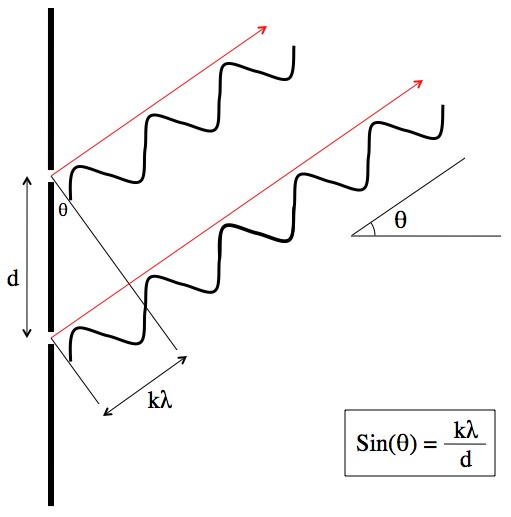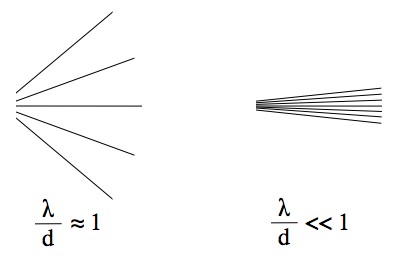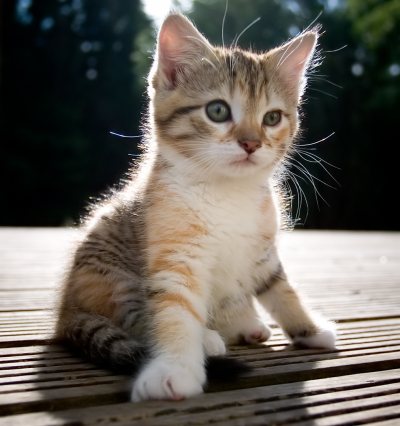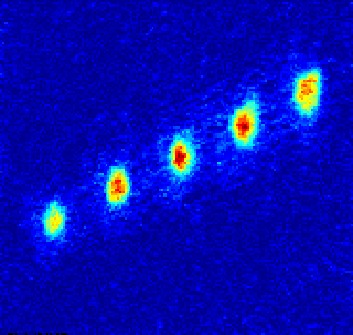Physicist: It helps to first get an idea of how the double slit experiment is done. The double slit experiment works for any particle, but in what follows I’ll use light to avoid confusion.
Shine light on two slits separated by some distance d. The light that emerges on the other side is free to scatter in any direction, but it doesn’t. Instead we find that it prefers a particular set of angles, and that these angles depend on d and the wavelength of the light, .
In the picture below the upward angle means that the light from the bottom slit has to take a slightly longer path. If the path difference is equal to a multiple of the wavelength, then the light from the two slits will be “in phase”, and will experience constructive interference.

Changing the angle changes the difference in path length from the two slits. When the difference is a multiple of the wavelength you get constructive interference.
It’s subtle, but already two assumptions have been made. 1) the screen that the light is being projected onto is very far away, so the light from the two slits, that gets to a particular point, follow roughly parallel paths. This is a reasonable assumption, and doesn’t cause any problems. 2) the light that comes out of the two slits is already in phase, and has the same wavelength. Luckily, there’s more than one way to skin a cat; either you use coherent (laser) light, or you make all the light come from a very small source (like another slit).
As a quick historical aside: When Thomas Young originally did this experiment he was looking at the interference pattern produced by allowing sunlight to pass through a colored filter (to get one ), then a single slit (to get the light “coherent”), then the double slits, then projected onto a wall. It was very dark, and (one can only assume) Young was very squinty. Tom was about the smartest person ever to live. He let the cat out of the bag for shearing forces, the Rosetta stone, and the transverse-wave nature of light, to name a very few. He was the polymath cat that ate the canary of science.
Back in the day (1924) fat cat Louis de Broglie, the 7th duke of Broglie, proposed the idea (later proven experimentally) that not only is light a wave; everything is. Kittens (the cute ones) have a mass of about 0.3kg, and old timey cannons have a muzzle velocity as high as the speed of sound (340 m/s). This translates to a de Broglie wavelength of .
Since kittens are about 0.1m long, the slits should each be about that size, and, say, 2m apart (larger slits need to be farther apart, to keep the interference fringes from overlapping). So d = 2m. Finally, you’d like the interference fringes on the screen to be several times farther apart than the kittens are large, otherwise you won’t be able to tell which kitten impact corresponds to which fringe. Say 1m apart, give or take.

The smaller the wavelength, the closer the fringes are together, and the harder it is to tell that there are fringes at all.
The separation between fringes is approximately , where L is the distance to the projection screen, and
is the angle between two adjacent fringes. For small angles you can use the aptly named “small angle approximation” for sine:
, and you’ll find that
. Since I’d like the fringes to be at least 1m apart,
and so
.
So, after passing through (both) of the double slits the cats will have to fly through about 330 quadrillion light years of purfectly empty space, before impacting the projection screen (on their feet, naturally). Unfortunately, the visible universe is just a hell of a lot smaller than that. Even so, this cat-astrophe is not the biggest problem with the cat-based double slit device.
Not to con-cat-enate the difficulties, but the biggest problems stem from the supreme challenge of generating a “coherent cat beam” (a “cat-hode ray”, as it were). Also, in order to get reasonable results from the experiment, it should be repeated at least 1036 times (about one hundred identical-to-the-last-atom-cats per fringe). As a quick aside; that’s too many cats.
In order to do the double slit experiment, especially when tiny wavelengths are involved, it’s very important that all of the particles involved are exactly identical and in phase. The best way to do this with light is to build a laser (which is an acronym for “Light Amplification by Stimulated Emission of Radiation”). Light (being made of bosons) obeys Bose-Einstein statistics, and as such the presence of a bunch of identical photons increases the likelihood of new identical photons being generated (that’s not obvious, so take it as read). Laser generation is an example of large scale entanglement, but unfortunately extending the technology to large scale cat entanglement would require all the yarn.
Coherent matter waves do exist, but so far they’ve all been made up of atoms in a Bose-Einstein condensate. It’s true what they say; curiosity and picokelvin temperatures killed the cat.
So to create a “caseo” (Cat Amplification by Stimulated Emission of Other cats), would require gathering so many exactly identical bosonic cats (“bosonic” here means an even number of protons, neutrons, and electrons), that the probability of new identical cats spontaneously forming from some kind of proto-cat particle soup becomes fairly high. Getting a “cat field” with entropy that low (zero) would be, I suspect, as difficult as herding cats.
But, if you can do that, then you can create a coherent cat-beam of absolutely identical cats. And once the 330 quadrillion light year long double slit apparatus is set up, you’re ready to go! Easy peasy!
No point in pussy-footing around it, there’s a reason why we don’t see quantum mechanical effects in “every day life” (with a few exceptions).









That was the most amazing answer I have ever read. Thank you.
I’ve been reading this site for a while, and this is definitely my favorite. Informative in a hilarious way.
Pingback: seantime» Blog Archive » Soon.
What if you were to blend the cats first? You could then reduce the weight required and therefore the total number of cats?
I already have the ASPCA all over my ass after the last couple thought experiments. For strictly moral reasons, it’s best to fire only healthy cats out of a cannon.
Also, that’s horrible.
Does the colour of the cats, or whether they’re shorthairs or longhairs, affect the result?
Absolutely. Any difference in the number of atoms, the breed, the velocity, the orientation, or the temperament will move the fringes around substantially, or even destroy them completely.
The field I went into hasn’t required me to use quantum mechanics since early grad school, and even then there wasn’t much emphasis on dynamics of kittens (I might have skipped that day), only touching on some kitten statics. So my thoughts on this might not be as thought out as I would like yet…
When I saw this I wondered about actual double slit experiments involving molecules, and found the paper “Quantum interference experiments with large molecules” by Olaf Nairz, Markus Arndt, and Anton Zeilinger. That paper makes it sound like, for single particle interference, you wouldn’t need complete coherence like in an atom laser. Instead it seems just having the wavelengths close enough to the same, you can get enough coherence from collimation. They were able to measure fringes despite the source of buckyballs being at 900 K and all of the various populations of internal states.
This leads me to think, that you wouldn’t need exactly identical kittens, you just need all of them to have roughly the same mass and velocity (I wouldn’t recommend the paper’s velocity chopper and 900 K oven source for kittens though). In fact, I think the criterion for seeing a fringe would work out to about (dm/m + dv/v) < 0.5 which gives rather loose requirements on how similar they have to be. Although the necessary collimating kitten optics might add considerably to the length needed for the experiment, and the kittens culled by collimators might be devastating to the required kitten budget.
(Although I think you might have overestimated the number of kittens needed, but I haven't thought that through yet.)
I’d have thought that paper would be trickier (but everyone should read it).
In the buckyball experiment they removed the importance of phase by firing the buckyballs rarely enough that the only thing that each one had to interfere with was itself (and everything is always in phase with itself).
My main concern was that a cat flying sideways might behave differently from a cat flying forward (particularly where the slits are concerned). Buckyballs avoid this problem almost entirely by being really symmetrical. But you’re right, it may not be a problem at all. However, it is important that the cats have (at the very least) very nearly exactly the same energy (mass), since the experiment is so sensitive to wavelength.
You might be able to drop the number of cats by several orders of magnitude, since the fringes closest to the center are far more likely. However, you’d still need a huge number of cats. I’ll go as low as 10^30.
…but if one were first to place the little kitties in little kitty straight jackets…
Did it died?
I like the cat-astrophe and cat-hode ray.
However, I do disagree any attempts to visualize quantum experiments, intended for subatomic particles, to be done using un-subatomic particles.
It goes into a cat-astrophe.
Hey, and what would be the role of the kittens as an observer during the experiment?
I didn’t want to get into the mundane details too much. To ensure that the kittens don’t decohere you have to blindfold them before loading them into the firing chamber.
Love the seriousness of the post as well as the puns 🙂
What if Schrödinger’s cat was used, it might only work half of the time. :). Very good read by the way!
As a dog person, I love this experiment!!! Cats out of cannons just seem like poetic justice to me!!!! lol
OK, perhaps this post didn’t contribute much to the discussion…But humor is always nice!! 🙂
Pingback: Q: Is there an experiment which could provide conclusive evidence for either the Many Worlds or Copenhagen interpretations of quantum physics? | Ask a Mathematician / Ask a Physicist
SERS_fabricator brings up Schrödinger, putting the two of us on a coherent wavelength.
What is it with physicists and the theoretical abuse of felines? Seriously, guys, there are a lot of other animals one could use for these thought experiments. Most of them are less cute, and also more cooperative.
I know I’m not the first person to bring this up. If you want to get a sense of how the cat feels, go to the Talk to Schrodinger’s Cat website, eliminating the apostrophe.
In the meantime, for this particular experiment, might I suggest that you use Hello Kitty? It’s easy to get multiple identical copies of her, in just about any size, in either 2D or 3D versions. And there are no laws against abusing fictitious animals, so that’s another bonus.
Just a thought.
Pingback: Q: What is the probability of an outcome after it’s already happened? | Ask a Mathematician / Ask a Physicist
Best article Ever. Ever.
edge of apparent universe , accelerating close to or perhaps attaining light speed. if matter gains mass approaching the speed of light does it not follow that the perimeter of the known universe is approaching infinite mass thus explaining outward accelaration and so called dark energy?
The “(with a few exceptions) part at the end deserves a link.
Beautiful!
But as PlasmaGryphon suggests, the double slit experiment doesn’t need a coherent beam as such, just coherence across the two slits. Placing the source a long way from the slits provides that. And it doesn’t need to be particularly monochromatic – you just get more visible fringes with a better light source. I’m guessing a classical cat-cannon would be fine as long as it was another 330 quadrillion light years before the slits.